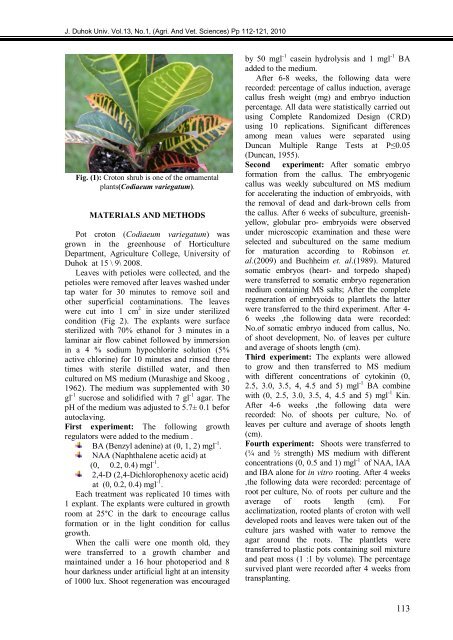The Influence Of Priming Two Cucumber Cultivar Seeds
The Influence Of Priming Two Cucumber Cultivar Seeds
The Influence Of Priming Two Cucumber Cultivar Seeds
Create successful ePaper yourself
Turn your PDF publications into a flip-book with our unique Google optimized e-Paper software.
J. Duhok Univ. Vol.13, No.1, (Agri. And Vet. Sciences) Pp 112-121, 2010<br />
Fig. (1): Croton shrub is one of the ornamental<br />
plants(Codiaeum variegatum).<br />
MATERIALS AND METHODS<br />
Pot croton (Codiaeum variegatum) was<br />
grown in the greenhouse of Horticulture<br />
Department, Agriculture College, University of<br />
Duhok at 15 \ 9\ 2008.<br />
Leaves with petioles were collected, and the<br />
petioles were removed after leaves washed under<br />
tap water for 30 minutes to remove soil and<br />
other superficial contaminations. <strong>The</strong> leaves<br />
were cut into 1 cm 2 in size under sterilized<br />
condition (Fig 2). <strong>The</strong> explants were surface<br />
sterilized with 70% ethanol for 3 minutes in a<br />
laminar air flow cabinet followed by immersion<br />
in a 4 % sodium hypochlorite solution (5%<br />
active chlorine) for 10 minutes and rinsed three<br />
times with sterile distilled water, and then<br />
cultured on MS medium (Murashige and Skoog ,<br />
1962). <strong>The</strong> medium was supplemented with 30<br />
gl -1 sucrose and solidified with 7 gl -1 agar. <strong>The</strong><br />
pH of the medium was adjusted to 5.7± 0.1 befor<br />
autoclaving.<br />
First experiment: <strong>The</strong> following growth<br />
regulators were added to the medium .<br />
BA (Benzyl adenine) at (0, 1, 2) mgl -1 .<br />
NAA (Naphthalene acetic acid) at<br />
(0, 0.2, 0.4) mgl -1 .<br />
2,4-D (2,4-Dichlorophenoxy acetic acid)<br />
at (0, 0.2, 0.4) mgl -1 .<br />
Each treatment was replicated 10 times with<br />
1 explant. <strong>The</strong> explants were cultured in growth<br />
room at 25°C in the dark to encourage callus<br />
formation or in the light condition for callus<br />
growth.<br />
When the calli were one month old, they<br />
were transferred to a growth chamber and<br />
maintained under a 16 hour photoperiod and 8<br />
hour darkness under artificial light at an intensity<br />
of 1000 lux. Shoot regeneration was encouraged<br />
by 50 mgl -1 casein hydrolysis and 1 mgl -1 BA<br />
added to the medium.<br />
After 6-8 weeks, the following data were<br />
recorded: percentage of callus induction, average<br />
callus fresh weight (mg) and embryo induction<br />
percentage. All data were statistically carried out<br />
using Complete Randomized Design (CRD)<br />
using 10 replications. Significant differences<br />
among mean values were separated using<br />
Duncan Multiple Range Tests at P≤0.05<br />
(Duncan, 1955).<br />
Second experiment: After somatic embryo<br />
formation from the callus. <strong>The</strong> embryogenic<br />
callus was weekly subcultured on MS medium<br />
for accelerating the induction of embryoids, with<br />
the removal of dead and dark-brown cells from<br />
the callus. After 6 weeks of subculture, greenish-<br />
yellow, globular pro- embryoids were observed<br />
under microscopic examination and these were<br />
selected and subcultured on the same medium<br />
for maturation according to Robinson et.<br />
al.(2009) and Buchheim et. al.(1989). Matured<br />
somatic embryos (heart- and torpedo shaped)<br />
were transferred to somatic embryo regeneration<br />
medium containing MS salts; After the complete<br />
regeneration of embryoids to plantlets the latter<br />
were transferred to the third experiment. After 4-<br />
6 weeks ,the following data were recorded:<br />
No.of somatic embryo induced from callus, No.<br />
of shoot development, No. of leaves per culture<br />
and average of shoots length (cm).<br />
Third experiment: <strong>The</strong> explants were allowed<br />
to grow and then transferred to MS medium<br />
with different concentrations of cytokinin (0,<br />
2.5, 3.0, 3.5, 4, 4.5 and 5) mgl -1 BA combine<br />
with (0, 2.5, 3.0, 3.5, 4, 4.5 and 5) mgl -1 Kin.<br />
After 4-6 weeks ,the following data were<br />
recorded: No. of shoots per culture, No. of<br />
leaves per culture and average of shoots length<br />
(cm).<br />
Fourth experiment: Shoots were transferred to<br />
(¼ and ½ strength) MS medium with different<br />
concentrations (0, 0.5 and 1) mgl -1 of NAA, IAA<br />
and IBA alone for in vitro rooting. After 4 weeks<br />
,the following data were recorded: percentage of<br />
root per culture, No. of roots per culture and the<br />
average of roots length (cm). For<br />
acclimatization, rooted plants of croton with well<br />
developed roots and leaves were taken out of the<br />
culture jars washed with water to remove the<br />
agar around the roots. <strong>The</strong> plantlets were<br />
transferred to plastic pots containing soil mixture<br />
and peat moss (1 :1 by volume). <strong>The</strong> percentage<br />
survived plant were recorded after 4 weeks from<br />
transplanting.<br />
111



